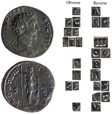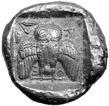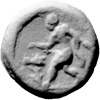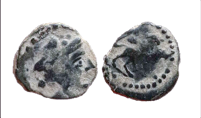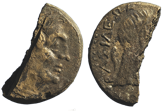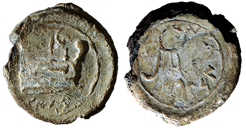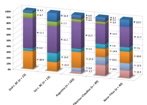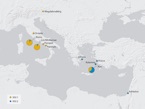Click on the image to download a file
The adjustment al marco of the weight of Roman Republican
denarii blanks by gouging.
L'Aggiustamento al Marco dei Tondelli di Denari della
Repubblica Romana con l'Uso di Sgorbie.
The monetary stock at Pompeii at the turn of the 2nd and 1st centuries BC:
pseudo-Ebusus and pseudo-Massalia.
The hub from ancient Spain reconsidered.
Two-headed and two-tailed denarii in the Roman Republic.
Iconographic parallels between the local coinages of central Italy and Baetica in the first century BC.
Tiberius right / globe and rudder.
Overstrikes and imitative coinages in central Italy
in the late Republic
A plated denarius brockage of L·RVSTI
Riconiazioni e monetazione imitativa nell’Italia centrale
nella tarda Repubblica.
Two-headed and two-tailed denarii again.
M·OCT IIIIVIR at Paestum, not P·MION IIIIVIR at Carteia:
the intellectual history of a misattribution.
With António Marques de Faria
‘Pseudo-mints’ and small change in Italy and Sicily in the late Republic.
With Suzanne Frey-Kupper
1965
1987
1988
1993
1995
1997
1998
2003
2005
2008
2009
2010
2011
A report on preliminary excavations in Tarzan’s Cave, Simonstown
Numismatic evidence for relations between Spain and central Italy
at the turn of the second and first centuries BC.
Les imitations pseudo-Ebusus/Massalia en Italie centrale : typologie et structure, présence dans les collections et dans les trouvailles de France
With Suzanne Frey-Kupper
Evaluating the money supply: were dies reproduced manually in antiquity
The iconography of two groups of struck lead
from central Italy and Baetica in the 2nd and 1st centuries BC.
end
Dies, hubs, forgeries and the Athenian decadrachm.
With Wolfgang Fischer-Bossert
La moneda en la Casa de Ariadna (VII,4,51-31) de Pompeya. El contexto arqueológico de las monedas de Ebusus y de las series imitativas de la pseudo-ceca de Pompeya. El contexto arqueológico de las monedas de Ebusus y de las series imitativas de la pseudo-ceca de Pompeya.
With Albert Ribera and Juan Salavert
Quartered and counter-marked Republican asses,
and the Central Italian Italo-Baetican assemblage.
Forthcoming
The Labours of Hercules on central Italian coins and tesserae of the 1st century BC

Pseudo-mints again: a die-study
With Federico Carbone
2013
A Central Italian coin with “Dionysus / panther” types, and contacts between Central Italy and Spain,
in the 2nd and 1st centuries BC.
With Alejandro García Sinner
A new coin of the Pompeian pseudo-mint, muling Ebusus and Athens.
With Giacomo Pardini
Monete dallo scavo stratigrafico della
Casa di Amarantus. (1, 9, 11-12)
Evidence for the importation and monetary use of blocks of foreign and obsolete coins in the ancient world
With Suzanne Frey-Kupper
Shipping tesserae from Ostia and Minturnae?
Coins of the Pompeian pseudomint from France
With Gisèle Gentric, Jean-Albert Chevillon
and Jean-Claude Richard Ralite
2015
2014
Central Italian coins with Dionysus/panther types from Hispania Ulterior
With Alejandro García Sinner
2016
Weight adjustment al marco in Antiquity,
and the Athenian decadrachm
Are Ebusdn and pseudo-Ebusan coin at Pompeii a sign of intensive contacts with the Island of Ebusus?
Cyrenaican coin from central Italy
with Samuele Ranucci
The crisis of small change in central Italy of the second and first centuries BC, and the function of overstriking
Identifying, documenting and understanding the transfer of blocks of minor foreign and obsolete coins in antiquity, for use as money: a note on methodology
With Suzanne Frey-Kupper
A plomo monetiforme from the Iberian settlement of Cerro Lucena (Enguera, Valencia) with a North-Eastern Iberian legend, and the Italo-Baetican series
With Alejandro G. Sinner, Noemí Moncunill Martí
and Joan Ferrer i Jané
More coins of the Pompeian pseudomint from France
With Jean-Albert Chevillon and Alejandro G. Sinner


















